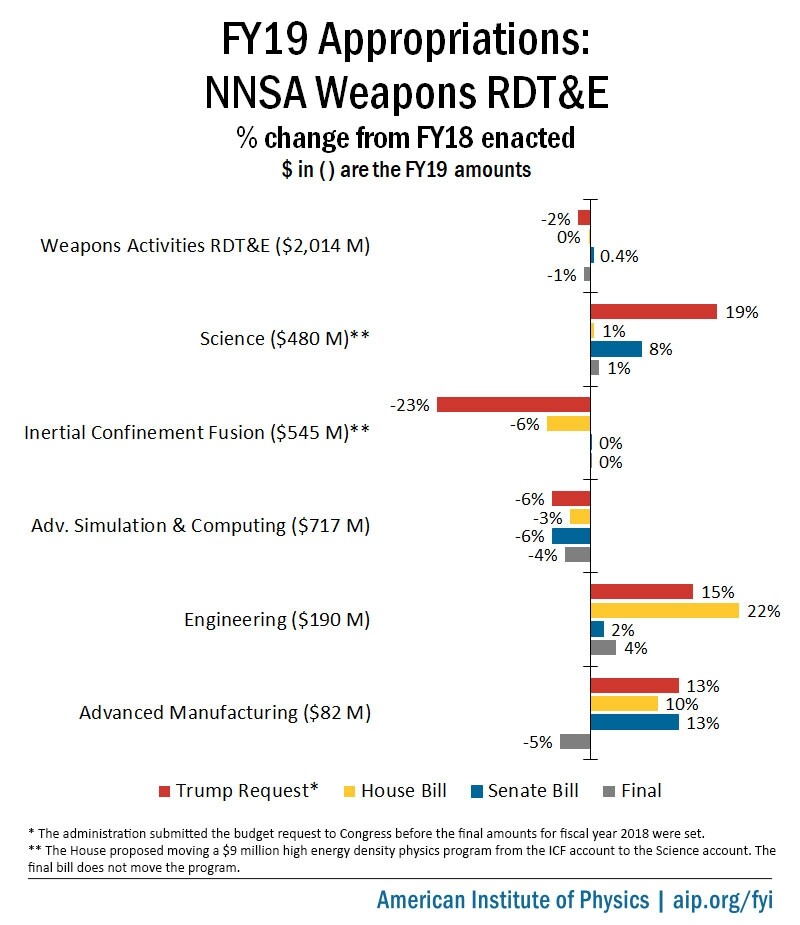
Final FY19 Appropriations: National Nuclear Security Administration
The final fiscal year 2019 appropriations bill for the Department of Energy includes a 4 percent overall increase for the National Nuclear Security Administration, bringing its total budget to $15.2 billion. Congress approved the appropriation last week as part of a three-bill package
The bill continues a multi-year spending surge that is financing a comprehensive modernization of the U.S. nuclear arsenal and its associated weapons production complex. These efforts are funded through NNSA’s Weapons Activities account, which has increased in the past decade from about $6.4 billion to just over $11 billion in fiscal year 2019. Within that account, funding for weapons-related research, development, test, and evaluation (RDT&E) activities is remaining steady this year at just over $2 billion.

Meanwhile, the budget for nuclear nonproliferation activities will decrease 3 percent to $1.9 billion. Much of the drop is attributable to a decline in construction funding for the Mixed Oxide Fuel Fabrication Facility, a troubled plutonium disposal project that the Trump administration is seeking to terminate. Most programs focused on nonproliferation-related R&D and securing nuclear materials will see level funding or increases.
An explanatory statement
Weapons Activities
New low-yield warhead. The bill includes $65 million requested by the Trump administration to begin development of a low-yield warhead for submarine-launched nuclear missiles. Many Democrats objected to the proposal, arguing that low-yield weapons lower the threshold to initiating nuclear war. Several of them recently introduced the “Hold the Low-Yield Nuclear Explosive (LYNE) Act,”
Inertial Confinement Fusion (ICF). The ICF program budget will remain level at $545 million. The administration had proposed cutting it by over 20 percent and initiating a three-year withdrawal of funding from the OMEGA Laser Facility at the University of Rochester. It justified the move as a “rebalancing” of the ICF program that would “strengthen long-term support for Stockpile Stewardship Program efforts” and free up resources for “higher NNSA priorities.”
Congress specifies a 7 percent increase for the OMEGA Laser Facility, bringing its budget to an all-time high

Technicians inspecting an optics assembly at the National Ignition Facility during a recent maintenance period.
(Image credit – Jason Laurea / Lawrence Livermore National Laboratory)
Science. The Science program budget will increase 1 percent to $480 million, which is considerably less than the requested $565 million. Most of the proposed increase was for the new Enhanced Capabilities for Subcritical Experiments (ESCE) program, which seeks to improve capabilities for studying the late stages of plutonium implosions. Although the U.S. has abided by a moratorium on explosive nuclear tests since the early 1990s, experiments that implode plutonium without initiating a self-sustaining chain reaction are still permitted.
The administration proposed to nearly triple the ESCE budget to just under $120 million to address a “physics gap” in the understanding of plutonium behavior under extreme conditions. It also sought to more than double funding for enhancements to the U1a Complex at the Nevada National Security Site, where the subcritical experiments are conducted. The final agreement increases the ESCE budget by 25 percent to $50 million and reduces the U1a upgrade budget by 11 percent to $20 million. The statement offers no explanation for not meeting the administration’s request, but the House report states that “significant portions of the technology are reported to be at low technology readiness levels and need to be advanced” before the ESCE project proceeds in earnest.
Advanced Simulation and Computing. NNSA’s contribution to DOE’s exascale computing initiative is funded at the requested level of $163 million, a slight increase over the current level. Acquisition of exascale-class computer cooling equipment at Los Alamos National Laboratory and facility modernization at Lawrence Livermore National Laboratory are funded at the combined requested level of $47 million. The overall budget for Advanced Simulation and Computing will decrease 4 percent to $717 million, with $13 million specified for “integrating artificial intelligence approaches into mechanistic modeling and prediction.”
Engineering. The budget for the Stockpile Responsiveness Program will increase 13 percent to $34 million as requested. Launched in earnest in fiscal year 2018 with a $30 million appropriation, the program is meant to complement the Stockpile Stewardship Program by providing weapons scientists and engineers with opportunities to exercise the full range of skills involved in developing nuclear weapons.
Infrastructure repair. In their respective Nuclear Posture Reviews
Defense Nuclear Nonproliferation
Nonproliferation R&D. The nonproliferation R&D account will rise 3 percent to $576 million, with proliferation detection increasing 1 percent to $282 million and nuclear detonation detection programs maintaining level funding at $196 million. Spending on nonproliferation fuels development will rise 19 percent to $98 million, with the amount allocated to the development of low-enriched uranium fuels for naval applications doubling to $10 million. U.S. Navy submarines and a number of its other vessels currently rely on highly enriched uranium fuels, which pose a proliferation concern.
Research reactor conversion. NNSA is directed to submit cost estimates for converting research reactors that rely on highly enriched uranium to alternative fuels. The provision is included in lieu of House report language that would have prohibited conversion of the Advanced Test Reactor at Idaho National Laboratory and the High Flux Isotope Reactor at Oak Ridge National Laboratory. The House report maintained that such conversion is prohibitively expensive and unnecessary given that the reactors are located on secure DOE sites.
Nuclear materials security. Programs dedicated to nuclear smuggling detection and securing nuclear and radiologic materials abroad will receive level funding at $154 million and $125 million, respectively, while the domestic radiologic security program will increase 15 percent to $127 million.
Plutonium disposal. Funding for the Mixed Oxide Fuel Fabrication Facility in South Carolina will decrease 34 percent to $220 million, which is equal to the amount the administration requested to close out the project. The administration believes the facility is no longer justifiable due to its ballooning costs and argues that placing the plutonium in a waste repository after diluting it would be a far cheaper means of disposal. It has also proposed
The statement specifies that construction of the project continue, but permits the funds to be used for other purposes if DOE certifies that an alternative disposal method is substantially cheaper. It also provides $25 million to advance design activities for the dilute and dispose strategy.




